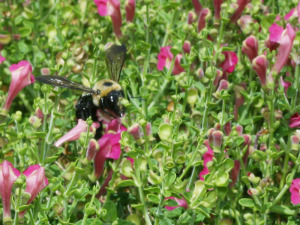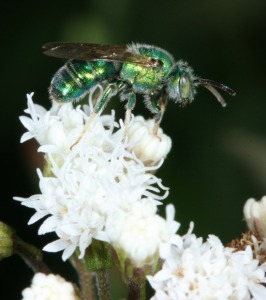
Bumble bees, important pollinators of many native plants, are becoming less common in many parts of Texas and around the country.
Pollinator protection has become almost trendy recently. One of the spin offs of the honey bee controversy over CCD, is that the spotlight has come to rest not just on honey bees, but on all insects that pollinate plants. And this is a good thing.
Today nearly everyone at some point is taught in school, or via Discovery Channel, that bees pollinate flowers; but I’ll wager that relatively few understand what this really means to all of us. Pollination is the biological process by which female plant parts are fertilized by the carrying of pollen from one plant to another. It is the plant’s equivalent of sex, only in this case it’s a ménage à trois. Without an insect middle man to carry male pollen to female plant parts, many plants could not produce seeds, or at least seed production would be much less.
Pollination is an essential part of the machinery of plant health and evolution. The hybrid vigor of cross pollinated plants, and the genetic diversity enabled by pollination would dwindle over time. Without pollination plants won’t necessarily die , but many plant populations would cease to thrive, and nature’s ability to respond to a changing earth environment would be gravely at risk.
So why the fuss over protecting pollinators? Why do they need our help? Pollinator populations in many areas are in decline, and not just in urban areas. Take the bumble bee…or I should say bumble bees. There are over 40 different species of bumble bees in the U.S. alone. In Europe, where bumble bees have been studied more carefully, over 18 species of bumble bees are considered threatened today. In the United Kingdom, a similar story can be told. There, three species have recently gone extinct. In the few studies of bumble bee population change in the U.S., many formerly common bumble bee species are found in fewer places, and bumble bee species are disappearing from many sites. And these aren’t the only kind of pollinator to be concerned about. There are 3,500 species of all kinds of bees in North America, each of which are pollinators, most of these are at some level of risk of decline.

Many pollinators, like this metallic halictid bee, are small enough to be overlooked by most people; but their value to plants goes far beyond their size.
Much of the concern about pollinator decline concerns loss of habitat. Bumble bees, for example, thrive best in diverse grassland habitats. And grasslands are one of our most threatened ecosystems, losing up to 400,000 acres a year to expanding crop production alone. Much less than 1% of original historic prairie remains in Texas, and less than 2% remains nationwide.
While one could argue that this is the necessary cost of human progress, there is much we can do to preserve our native pollinators. The first step is education. The Xerces Society maintains a Bring Back the Pollinators page and Texas Parks and Wildlife maintains an informative site on Texas bumble bees. In addition, for those of you in the north Texas area, there will be a Pollinator Powwow on Saturday, November 15, in Mansfield, TX. Cost is $15 for a full day of training and lunch. If you have any interest in making a difference for pollinators, you owe it to yourself to check this out.